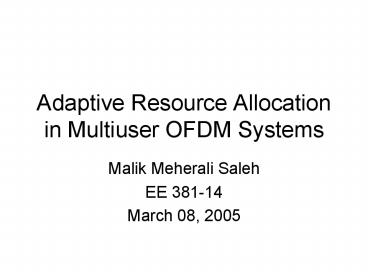Adaptive Resource Allocation in Multiuser OFDM Systems PowerPoint PPT Presentation
Title: Adaptive Resource Allocation in Multiuser OFDM Systems
1
Adaptive Resource Allocation in Multiuser OFDM
Systems
- Malik Meherali Saleh
- EE 381-14
- March 08, 2005
2
Introduction/Background
- 4G cellular system proposes hybrid of
- Multiple Input Multiple Output (MIMO)
- Orthogonal Frequency Division Multiplexing (OFDM)
- OFDM eliminates Intersymbol Interference
- TDMA/FDMA solutions for Multiuser OFDM
- Fixed allocation of subcarriers
- Multiuser Environment
- Creates channel diversity
- Assign users high gain subcarriers
- Motivation Adaptive Multiuser OFDM systems
3
Key Paper 1Wong, Cheng, Letaief and Murch,
1999
- Optimal Minimize total transmit power
- Perfect Channel knowledge assumed
- Assumes fixed data rate for users
- Adaptive assignment of subcarriers, bits and
power level to each user. - Suboptimal solution
- Subcarrier allocation
- Single user bit allocation is applied to the
assigned subcarrier for each user
4
Key Paper 2Jang and Lee, 2003
- Fixes total transmit power and maximizes sum
capacity - Applies Subcarrier allocation first
- Follows it up by transmit power allocation
- Provides 2 methods for power allocation
- Water filling policy
- Equal distribution
- Results show total data rate increases with
increase in users
5
Key Paper 3Shen, Andrews and Evans, (Draft)
2004
- Focus on Quality of Service parameter
- Power constraint with adaptive rate
- Maintains proportional rates between users
- Predetermined ratios, variable fairness index
- Reduce computation complexity by suboptimal
algorithm - Subcarrier allocation
- Maximizing sum capacity with Power allocation
- Both blocks include proportional values
6
What I propose to do
- I propose to study Paper 2 and 3 in detail and
simulate them with controlled parameters and
compare them on BER/signal quality, sum capacity,
the number of users, average channel power per
user. - Simulation files
- I plan to use the simulation files provided for
Paper 3 at http//www.ece.utexas.edu/bevans/proje
cts/ofdm - For Paper 1, I hope to get in touch with the
authors for the simulation code - I will also compare sum capacity of Paper 2 3
to TDMA/FDMA approach in Multiuser OFDM
PowerShow.com is a leading presentation sharing website. It has millions of presentations already uploaded and available with 1,000s more being uploaded by its users every day. Whatever your area of interest, here you’ll be able to find and view presentations you’ll love and possibly download. And, best of all, it is completely free and easy to use.
You might even have a presentation you’d like to share with others. If so, just upload it to PowerShow.com. We’ll convert it to an HTML5 slideshow that includes all the media types you’ve already added: audio, video, music, pictures, animations and transition effects. Then you can share it with your target audience as well as PowerShow.com’s millions of monthly visitors. And, again, it’s all free.
About the Developers
PowerShow.com is brought to you by CrystalGraphics, the award-winning developer and market-leading publisher of rich-media enhancement products for presentations. Our product offerings include millions of PowerPoint templates, diagrams, animated 3D characters and more.

